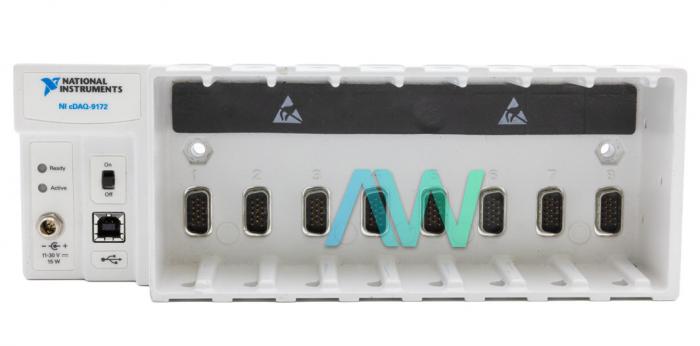Setup and Optimize the National Instruments PXI-5441 Waveform Generator
The National Instruments PXI-5441 is a powerful PXI waveform generator designed to support high-speed waveform downloads up...


National Instruments (NI) offers two popular options for data acquisition and control: the CompactDAQ (cDAQ) and the CompactRIO (cRIO). While both excel in specific areas, understanding their core differences can help you to make an informed decision about which device will be most effective. This article will highlight the key distinctions between cDAQ and cRIO, exploring their processing capabilities, ideal applications, and customization options.
The primary purpose of the CompactDAQ (cDAQ) is to work together with a host computer (PC). It comes in various chassis sizes with different slot configurations, offering flexibility for various project needs. The backplane, which acts as the communication backbone, determines how modules interact with the chassis (e.g., NI-STC for cDAQ). This device functions as a high-performance data gathering device that depends on the PC for processing despite having very little processing capability onboard. With this configuration, the cDAQ is able to collect accurate data and send it back to the PC, which is where the majority of analysis and control decisions are made. The cDAQ is an extension that the PC uses as the central nervous system to efficiently collect data from a variety of sensors and inputs.
With a Field-Programmable Gate Array (FPGA) and an integrated real-time CPU, the CompactRIO (cRIO) is a more independent system. With this setup, the cRIO can independently decide how to handle situations and analyze data without needing to be constantly connected to a PC. With hardware-level customization possible thanks to the FPGA, complicated processes can be completed quickly and precisely timed. Because of its independence and processing power, the cRIO is appropriate for applications that need dependable performance under a variety of circumstances as well as real-time responsiveness.
The cDAQ is an exceptional device to utilize when high-fidelity data collecting is required but on-device real-time decision-making is not. The main requirement in typical use cases, such as data logging, sensor monitoring, and validation testing, is to capture and transport data for later analysis on a PC. Programming and analysis are made easier by the cDAQ’s seamless connection with a well-known PC environment, which makes it a practical option for a variety of testing and monitoring applications where the speed at which decisions are made is not crucial.
Applications requiring on-device analysis and real-time control are where the cRIO excels. It works well for embedded control systems that operate in challenging situations where a PC might not be feasible, as well as automated test systems with strict time constraints. For activities requiring instant responsiveness and dependability, such industrial automation, robotics, and mission-critical control systems, the cRIO is a great option because of its quick reaction time and autonomous decision-making capabilities.
Apex Waves specializes in NI hardware system maintenance. With the largest collection of obsolete NI modules, including the cRIO and cDAQ, we assist customers in maintaining the functionality of their old systems for as long as possible.
View our website to explore our products and manufacturers, or contact us to receive a quote!
The wide variety of compatible I/O modules and the modular design of the cDAQ provide flexibility. By choosing specific modules that satisfy their measurement requirements, users can customize their data acquisition system. These modules include analog and digital input/output (I/O), communication modules for connecting to external devices, and more. However, rather than processing power, the main customizing factors are the kind and quantity of I/O channels. Because of the cDAQ’s functional architecture, users can easily configure and reconfigure for different data collecting activities, guaranteeing adaptability to varied test situations and experimental settings.
The cRIO offers a high degree of flexibility and customization, extending beyond just the selection of I/O modules. Specific control algorithms, signal processing jobs, and real-time data analysis can be encoded into the FPGA and real-time processor. With this degree of personalization, users can design extremely customized solutions that meet their unique needs. The cRIO’s configurable hardware and software environment offers unmatched precision and versatility for both advanced industrial automation solutions and quick control system prototyping.
Whether you require high-fidelity data logging with direct PC integration or real-time control for complex industrial automation, NI’s cDAQ and cRIO systems offer powerful solutions. By understanding their strengths in processing power, application suitability, and customization, you can select the best tool to streamline your testing and control operations. NI offers cDAQmx software for programming and data acquisition with cDAQ, while LabVIEW Real-Time and FPGA programming are used for cRIO.
Want to learn more about National Instruments systems like the cDAQ and cRIO? Check out our blog and explore trending topics, how-to guides, and more.
A monthly email packed with valuable content—industry news, tutorials, obsolescence updates, and more. No sales pitches, just insights we think you'll find helpful!
The National Instruments PXI-5441 is a powerful PXI waveform generator designed to support high-speed waveform downloads up...
Companies in almost every industry are being transformed by artificial intelligence, and autonomous machines are...
The PXIe Platform from National Instruments offers an incredibly valuable toolset for test and measurement innovation. Its...
It is no secret that simulation and testing is an important part of designing circuits....